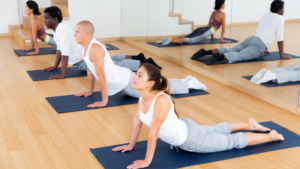Discover how to tailor your fitness routine to suit your age and ability level and lead a healthier, happier life.
A healthy and active lifestyle is essential for individuals of all ages and stages of life. In today’s world, fitness has taken a center stage as more people are becoming aware of the importance of staying healthy and fit. However, what many folks do not realize is that different stages of life require different approaches to exercise to promote long-term wellness.
In this article, we will reveal tips on how to modify your workout regimen for different life phases and achieve optimal fitness, wellness and health throughout life.
Laying the Foundation for Lifelong Well-Being:
Childhood is a crucial phase in life, and it lays the foundation for a lifetime of healthy living. In childhood, exercise should focus on developing motor skills, coordination, and making exercise enjoyable through sports, fitness games, and other playful activities. Fitness during childhood can help cultivate positive habits and set the stage for healthy living later in life.
Prioritizing Mobility and Flexibility in Golden Years:
Retirement can be the best years of one’s life for physical fitness and fun activities. However, it is essential to prioritize mobility and flexibility during this phase of life. According to studies, we lose 10% of muscle mass each year after 30. Therefore, low-impact workouts, joint-health-focused activities, and yoga become key to maintaining and even increasing flexibility and mobility with age. Fitness programs tailored to the changing needs of seniors can help improve their quality of life while keeping them active and healthy.
Customizing Exercise Regimens for Pregnancy and Postpartum Phases:
Pregnancy and postpartum periods are other crucial phases of life where special attention should be given to fitness. Proper exercise regimens during pregnancy and postpartum period help to replenish the body’s minerals, reduce the risk of heart diseases and promote recovery. For the new mother, it is vital to find exercises and outdoor activities that can help fight postpartum depression. Customized exercise routines targeted at mother and infant’s health can help improve strength, overall well-being and lead to quicker recovery after birth.
Here are some valuable tips to help you personalize your fitness regimen:
Know Your Limits:
Understand your current physical condition and any limitations you may have. Consider factors such as age, previous injuries, and medical conditions. Consulting with a healthcare professional or a certified personal trainer can provide valuable insights into designing a safe and effective workout plan.
Set Realistic Goals:
Establish achievable fitness goals based on your age and ability level. Whether it’s improving flexibility, building strength, or enhancing cardiovascular health, setting realistic targets will keep you motivated and prevent burnout. Remember, progress takes time, so be patient with yourself.
Choose Suitable Activities:
Select exercises that are appropriate for your age and fitness level. Low-impact activities like walking, swimming, or yoga are excellent options for individuals with joint issues or mobility concerns. Gradually incorporate more challenging exercises as your strength and endurance improve.
Focus on Functional Fitness:
Emphasize functional exercises that mimic movements you perform in daily life. This includes activities such as squats, lunges, and core exercises, which enhance balance, stability, and overall functional strength. Functional fitness not only improves your quality of life but also reduces the risk of falls and injuries, especially as you age.
Prioritize Recovery and Rest:
Pay attention to recovery and allow your body adequate time to rest between workouts. Incorporate rest days into your routine to prevent overtraining and minimize the risk of injuries. Additionally, prioritize quality sleep, proper nutrition, and hydration to support your body’s recovery process.
Listen to Your Body:
Tune in to your body’s signals and adjust your workout intensity accordingly. If you experience pain or discomfort during exercise, take a step back and modify the activity or seek professional guidance. Pushing through pain can lead to injuries and setbacks, so it’s essential to prioritize safety and well-being.
Stay Consistent:
Consistency is key to achieving long-term fitness success. Make exercise a regular part of your routine by scheduling workouts at convenient times and sticking to your plan. Find activities that you enjoy and incorporate variety to keep things interesting and maintain motivation.
Monitor Progress and Adapt:
Keep track of your progress by monitoring key indicators such as strength, flexibility, and endurance. Regularly reassess your goals and make necessary adjustments to your fitness routine as you progress or encounter challenges. Adaptability is essential for sustained improvement and overall well-being.
Achieving total well-being through a customized workout routine is vital at every stage of life. Proper exercise and fitness can positively impact your lifelong health and help you live a healthy and happy life. So, stay active, identify your fitness level and age-specific requirements, and always remember that there is an exercise for every stage of life!
Also Read: Optimizing Your Sleep: A Guide to Enhancing Your Sleep Quality






